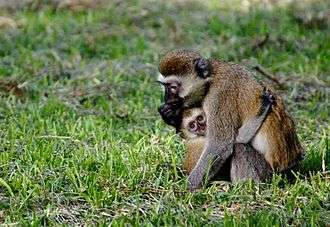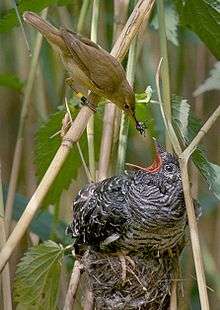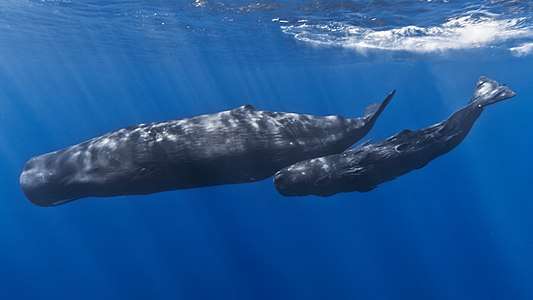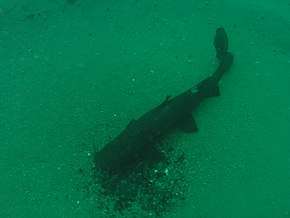Alloparenting
Alloparenting (also referred to as alloparental care) is a term used to classify any form of parental care provided by an individual towards a non-descendant young.[1] Non-descendant refers to any young who is not the direct genetic offspring of the individual, but does not exclude related young such as siblings or grandchildren.[2] Individuals providing this care are referred to using the neutral term of alloparent (or 'helper').[1]

Alloparental care encapsulates a diverse range of parenting systems across a range of animal groups and social structures. The alloparent-young relationship can be mutualistic or parasitic, and between or within species. Cooperative breeding, joint brood care, reciprocal allonursing, brood parasitism and cuckoldry represent situations in which alloparenting plays a role.
| Look up alloparenting in Wiktionary, the free dictionary. |
Theory
In biology, ethology and sociology, alloparental care is defined as any form of parental care, which is directed towards non-descendant young.[2][1] It was first used by Edward O. Wilson in 1975, in his book Sociobiology in an attempt to define a neutral term which could encapsulate the gender and relation specific terms of 'aunite' and 'auncle' which had previously been coined in the literature to describe this sort of behaviour.[3] In addition, Wilson used the term alloparent (or 'helper') to refer to the individuals providing the care, and proposed allomaternal and allopaternal as phrases that could be used to distinguish the sex of the helper. The word alloparent roughly translates to "other-parent" based on the Greek root "allo", meaning other, and the Latin root "parens", meaning parent.
Alloparenting encapsulates a diverse range of parenting systems and behaviours. Simply, it can be understood as a system of parenting in which individuals other than the direct genetic parents act in a parental role, either for a short, or extended period of time. This definition does not exclude alloparents who are genetically 'related' to the offspring, such as siblings and aunts, who are often observed as 'helpers at the nest'.[4] In instances where this is the case, the alloparent and the offspring share a degree of relatedness (r [the coefficient of relatedness] > 0), and therefore kin selection is often involved in the evolution of the behaviour.[5][6] Use of the term non-descendant young, as opposed to non-related young is therefore an important distinction in the definition of alloparenting. The non-descendant young in whom the alloparent invests can be conspecific (of the same species) or heterospecific (of a different species), a phenomenon often observed in fish and a select number of bird species.[2]
There is some debate as to whether interspecific alloparenting (caring for the young of another species) constitutes 'true' alloparental care, particularly when the relationship is parasitic for the alloparent, and the care being directed is therefore 'misdirected' or constitutes a maladaptive behaviour.[7] Though such parasitic relationships, such as what occurs with cuckoo chicks, were not specifically addressed by Edward O. Wilson in his original discussion, adoption and slavery across species in ants was discussed; a relationship which could be described as parasitic for the heterospecific young.[1] This article will consider interspecific and parasitic alloparental behaviours to satisfy the definition of alloparental care.
Alloparental investment
In 1972, Robert Trivers defined parental investment as: "any investment by the parent in an individual offspring that increases the offspring's chance of surviving (and hence reproductive success) at the cost of the parents ability to invest in other offspring" (Trivers, 1972).[8]
This concept of parental investment applies to the alloparent in the same way that it does to the genetic parent; however, any investment into the production of gametes, which Trivers included in his definition, is not relevant, and is therefore usually restricted to behavioral considerations for the alloparent.[2] Possible forms of investment provided by an alloparent can be defined by three of the four classifications of energy expenditure proposed by Crawford and Balon (1996):
- Type II – Preparing for the offspring prior to zygotic development in terms of nest/den building and territory defense.
- Type III – Direct provisioning of food for the young.
- Type IV – Tending to, caring for, feeding, defending and teaching the young.
Given that the alloparent is never the genetic parent, and was therefore not involved in the reproductive behavior/copulation that produced the young, the Type I classification, 'energy investment in gametes', is not relevant when we consider alloparental investment.[9]
Classification
The forms of alloparental care which occur in nature are numerous and varied and resist classification. Relationships between the alloparent and the young, and the alloparent and the genetic parent, range from cooperative and mutualistic to exploitative and parasitic.[10] The below outline provides one classification for the many forms of alloparenting which have been observed:
'True' (mutualistic)
This form of alloparenting is characterized by interactions/relationships which provide and overall fitness benefit to the alloparent, the young, and the genetic parent.[2] This sort of parental care is often closely tied to social organisation and is thus very common in advanced animal societies such as primates.[1] It can take on the forms of:
- Cooperative breeding – This system of breeding is characterised by individuals (alloparents) who delay or forego their personal reproduction in order to assist in the reproduction of other individuals within the group, often a dominant breeding pair.[1] The alloparent 'helpers' are most commonly the siblings of the new offspring, or siblings to the breeding pair. This system is common amongst birds, primates and mammals such as the blackbacked jackal,[11] and African wild dogs who share in pup feeding and display 'babysitting' behaviour.[12] Cooperative breeding is often provided as strong evidence in support of kin selection.[1] Cooperative breeding, particularly in birds, is favored in marginal environments where food is limited or there are high predation rates and it is therefore tough for a breeding pair to successfully raise young on their own.[4] Newly independent young may also find alloparenting the most successful reproduction option available to them in environments where the resources are scarce or there is habitat saturation. An extreme case of cooperative breeding is what occurs in eusocial insects such as some bee and ant species where a caste system has evolved and workers forgo their personal reproduction to aid in the reproductive success of the colony, gaining indirect fitness benefits through assisting related young.[13]
- Joint brood care ('babysitting') – Communal care of broods is similar to cooperative breeding, but more commonly involves a number of reproductive pairs or mothers. Sometimes referred to as 'babysitting' or reciprocal cooperation, this system of parenting allows the genetic parents greater foraging freedom, and appears to be supported by the mutual benefits participating individuals acquire through reciprocal altruism.[4] Reciprocal altruism involves individuals performing acts to increase the fitness of another individual, in the hope that the act will be reciprocated.[8] It is not dependent on relatedness, and therefore, babysitting behaviour is often observed amongst non-kin. This form of alloparental care has been observed in reindeer and elk who display reciprocal allonursing and form 'nursery' herds,[14] and vampire bats who display reciprocity in food sharing.[15] Babysitting females are frequently observed in primate species, such as the ring-tailed lemur, vervet monkeys, rhesus macaques and langurs.[4] The formation of nursery groups has also been reported in the Atlantic bottle-nose dolphin and sperm whales. There are some cases in which brood amalgamation between two species has been observed. In Lake Malawi, cichlid parents are seen to 'farm out' their brood into the brood a potential predator, the Bagrus meridionalis catfish, and remain to help defend against predators.[2] Intriguingly, the catfish's care of heterospecific young is mutualistic for all parties.[16]

'Misdirected' (parasitic)
Relationships between 'parents' and young that are in some way parasitic, perhaps resulting from reproductive errors or maladaptive behaviour, constitute an interesting and somewhat hazy form of alloparental care. In some cases, alloparents may find themselves investing in heterospecific young, and gaining none, or very little overall fitness benefit. Although ultimately maladaptive, this sort of behaviour may be supported by an inability of parents to recognise their own young (for example stolen fertilisations in fish), or supernormal stimuli 'enslaving' the alloparent into providing the care, as is seen in the case of brood parasitism of the cuckoo bird.[4] The genetic parents and the young are not exempt to parasitism and exploitation either. In some species of fish, males exhibit zygote stealing, or alloparents may kidnap free-swimming young to help reduce selective pressures on their own brood.[2] In some cases, alloparents may exploit young in order to receive immediate benefits. In some primate species, low ranking individuals, particularly males, will temporarily care for young in order to increase social status, gain reproductive benefits or use them for 'agonistic buffering', often with little concern for the welfare of the young.[17] Two well-documented types of parasitic or misdirected alloparenting are:
- Brood parasitism: this is where the genetic parent will leave their young in either the care of a conspecific or heterospecific alloparent who commonly has a brood of their own.[18]
- Cuckoldry: this occurs in many colonially breeding bird species where extra-pair copulations may take place and the males end up caring for unrelated offspring.[19]
Benefits
To the alloparent
Benefits acquired by the alloparent are dependent on the form of alloparental care, but range from:
- Indirect fitness benefits gained via kin selection
- Parental experience: gaining mothering/parental practice through 'babysitting' can increase the likelihood that the alloparents future genetic offspring will survive.
- Increase in social rank
- Extra-pair breeding opportunities/acquisition of mates
- Protection from predation during cooperative breeding or joint brood care.
- 'Agonistic buffering': individuals may enlist the influence of young within a group as protection during aggressive interactions.
- Acquisition of home territory following cooperative breeding
- Increased survival of genetic offspring during joint brood care
To the young
_pups_..._(33219391176).jpg)
In almost all forms of alloparenting, the young receives an overall fitness benefit from the care provided. In cooperative breeding or joint brood care, the presence of 'helpers' at the nest or den will usually increase the young's probability of surviving. This has been observed in a number of species including the black-backed jackal (Canis mesomelas).[11] In a study of jackal groups in Tanzania spanning three and a half years, it was found that the presence of sibling helpers in the den had a significant positive correlation to offspring survivorship. Through helping feed the mother and her pups, guarding the litter, and contributing to their grooming and learning of how to hunt, each helper in addition to the parents, added 1.5 surviving pups to the litter.[20] By helping raise their full siblings, with whom they share a coefficient of relatedness of 1⁄2, the helpers were benefiting from increasing their inclusive fitness.
In cooperative breeding
In cooperative breeding, mothers are able to conserve energy, travel further away from nesting grounds to forage for food/supplies, maintain social interactions, and better protect their offspring from predators. The offspring that experience alloparental care benefit from increased protection from predators, development of social cues, and learning group dynamics through social interactions. The alloparents benefit as they are given the opportunity to gain mothering skills before they have reached reproductive age.[21] The relationships formed through alloparenting have also been seen to enhance the stability of the family, herd, or community over time.[22]
Costs
To the young
In some instances of alloparental care the young are exploited, which may lead to mistreatment by the alloparent. An example of this is when male primates use young for 'agonistic buffering' during confrontations with dominant males.[4] If the alloparents are inexperienced as parents, this could pose as a danger to the young. In some cases of brood amalgamation, young are positioned in a way that subjects them to greater predation risk than the genetic young of the alloparent.[23]
To the alloparent
Alloparenting, given that the behaviour is often initiated by the alloparent, is rarely a costly act for the individual providing the care. Instances where the alloparent receives no benefits, or incurs a cost, generally involve parasitic relationships, where the individual has performed a reproductive mistake, or is misdirecting their parental care.
Evolution
In many discussions of alloparental care, the comment is often made that alloparenting can at first appear altruistic.[2][4] This appearance stems from the fact that benefits to the alloparent are very rarely immediate, and any fitness benefits gained are indirect. Though alloparenting systems based on reciprocal altruism are well studied, purely altruistic care provided by an alloparent has not been observed. Two of the main evolutionary driving forces of alloparental behaviour are kin selection and reciprocal altruism.[8][6] In cases where the alloparent and young share no degree of relatedness, other benefits to the alloparent will have contributed to the evolution of the behaviour, such as 'mothering-practice' or increased survivorship through association with a group.[4] The cases where an evolution of such behaviour is most difficult to explain are parasitic relationships such as the cuckoo chick in the nest of a smaller host parent. Behavioral ecologists have cited supernormal stimuli, reproductive errors, or the inability of alloparents to recognize their young as explanations that may support this behaviour.[10]
In general, the occurrence of alloparental care is the result of both the life history traits of the species (how their evolution has predisposed them to behave), and the ecological conditions in which the individual finds themselves.[10]
Evolution of cooperative breeding
Cooperative breeding constitutes a unique case of alloparenting with a specific evolution. It is a key example of where the evolution has been driven by the combination of life history traits and ecological factors, which act as the triggers.[10] The first hypothesis put forward for the evolution of cooperative breeding was that a shortage of suitable breeding habitat encouraged young to remain at the nest or territory for a period of time before attempting to raise their own young.[24] For example, habitat saturation was shown to be responsible for the occurrence of cooperative breeding in the Seychelles warbler, a small passerine bird.[25] It was also observed that remaining at the nest correlated to a higher chance of inheriting the parent's territory. Additional ecological constraints have since been proposed as factors favoring cooperative breeding:[26]
- Reduced survival probability following dispersal
- Reduced probability of finding a mate
- Reduced chance of successful breeding once a territory has been established
As a result, cooperative breeding is often seen in populations where there is:
- High population density
- Intense competition for food, territory and resources
- Stable environment
This has in turn selected for species producing a small number of offspring who require a large amount of parental care.[10]
In nature
Alloparenting behavior is known from 120 mammal and 150 avian species.[4] "In mammals, care typically encompasses allolactation, pup-feeding, babysitting and carrying young."[27] This is seen when male Barbary macaques carry around unrelated infants and care for them for hours at a time.[28] Another example is when warthog sows suckle piglets from other litters after the sows have lost their own litters.[29]

'Babysitting' in sperm whales
Sperm whales (Physeter macrocephalus) are deep diving cetaceans that exhibit alloparental care in the form of 'babysitting'. When the whales are young, they are not able to dive to and remain at the depths that their mothers frequent in order to graze and feed. Yet being left at the surface alone makes them vulnerable to predators like killer whales and sharks.[30] Sperm whale social groups appear to modulate their diving behaviour in order to provide alloparental care to young within the group and reduce the time they spend alone at the surface, at the same time allowing the mother greater foraging freedom. They do this by changing the synchronicity of their dives to limit the time a young whale spends alone.[30] As the 'babysitters' or alloparents dive and resurface the calves swim between them and therefore care is provided by a number of members within the social group.

Interspecific brood amalgamation
In Lake Malawi, it has been observed that a select few species of cichlids will 'farm out' their young into catfish (Bagrus meridionalis) broods, a larger predatory fish.[2] In many cases the cichlid parent will remain close by to participate in mutualistic defense of the young. In a study by Mckaye et al. (1985), 50% of observed catfish broods contained cichlid young; with the catfish offspring in these broods having six times greater survivorship.[16] This increased survivorship of the alloparent's young has been linked to the dilution effect, and the way that the geometry of the interspecific school is manipulated such that the cichlid young are forced to the periphery, where they are more vulnerable to predation.[23] It is through this manipulation that the catfish young gain greater protection from predators. Although placed in a more vulnerable position, the cichlid young still benefit from the interaction; both their genetic and 'allo' parents defend against predators (mutualistic defense), and being a mouth breeding species, this 'farming out' (which frees them from the mouth) may allow the cichlid young to forage more and grow faster. It has also been observed that the bagrid catfish alloparent will allow the cichlid young to feed off the skin on its dorsal surface.[23] This case of interspecific brood care, which in some cases results in full adoption, is unique in that it is uncommon to see care of heterospecifics where the relationship is mutualistic for all parties.[16]
In humans
Alloparenting in humans is a common form of parental care in a variety of cultures and can include care giving from siblings, grandparents, other relatives and unrelated family members such as teachers for providing learning and support. One particular example is a situation in which grandparents adopt a parental role. This is sometimes named a "skipped generation household". In 1997, 8% of children in the United States lived with their grandparents, with the grandparents being the caregivers in one third of those cases.[28] According to Deihl,[31] the Efé people of Ituri Forest in the Democratic Republic of Congo practice alloparenting, with care for infants coming from siblings, grandparents, and older members of the community. Deihl states that where siblings are alloparents this provides adolescents experience of being a parent.
Human psychology in alloparenting
The traditional model of child psychology in relation to parents is called, "Classical Attachment" in which the child has a strong attachment to one figure (the mother). In alloparenting communities, attachment theory suggest that the same sort of bond is shared between the child and multiple community members.[32] This has potential advantages for the child and the parents. The child has a diversified network of caregivers which can provide intimate emotional support.[33] The parent's cost of child rearing goes down as well as the emotional cost and cost of tangible resources. According to The US National Library of Medicine, alloparenting has proven to activate portions of the brain that are correlated with decreasing stress levels.[34]
References
- Wilson, E. O. (1975). Sociobiology: the new synthesis. Cambridge, Mass.: Belknap Press of Harvard University Press.
- Wisenden, Brian D (1999). "Alloparental care in fishes". Reviews in Fish Biology and Fisheries. 9 (1): 45–70. doi:10.1023/a:1008865801329.
- Rowell, T. E.; Hinde, R. A.; Spencer-Booth, Y. (1964). ""Aunt"-infant interaction in captive rhesus monkeys". Animal Behaviour. 12 (2–3): 219–226. doi:10.1016/0003-3472(64)90004-1.
- Riedman, Marianne L. (1982). "The evolution of alloparental care and adoption in mammals and birds". The Quarterly Review of Biology. 57 (4): 405–435. doi:10.1086/412936.
- Hamilton, William D. (1964). "The genetical evolution of social behaviour. II" (PDF). Journal of Theoretical Biology. 7 (1): 17–52. doi:10.1016/0022-5193(64)90039-6. PMID 5875340.
- Hamilton, William D. (1664). "The genetical evolution of social behaviour. I". Journal of Theoretical Biology. 7 (1): 1–16. doi:10.1016/0022-5193(64)90038-4. PMID 5875341.
- Coyne, Jerry A.; Sohn, Joel J. (1978). "Interspecific brood care in fishes: reciprocal altruism or mistaken identity?". The American Naturalist. 112 (984): 447–450. doi:10.1086/283287.
- Trivers, Robert L (1971). "The evolution of reciprocal altruism". The Quarterly Review of Biology. 46 (1): 35–57. doi:10.1086/406755.
- Crawford, Stephen; Balon, Eugene K. (1996). "Cause and effect of parental care in fishes: an epigenetic perspective". Advances in the Study of Behavior. 25: 53–107.
- Krause, Jens; Ruxton, Graeme D (2002). Living in Groups. Oxford University Press. ISBN 978-0198508182.
- Gubernick, D. J.; Klopfer, P.H. (1981). Parental care in mammals. New York: Plenum Press.
- Kühme, Wolfdietrich (1965). "Communal food distribution and division of labour in African hunting dogs". Nature. 205 (4970): 443–444. Bibcode:1965Natur.205..443K. doi:10.1038/205443a0.
- Winston, M. L. (1991). The biology of the honey bee. Harvard University Press.
- Engelhardt, Sacha C.; Weladji, Robert B.; Holand, Øystein; Røed, Knut H.; Nieminen, Mauri (2015). "Evidence of reciprocal allonursing in reindeer, Rangifer tarandus". Ethology. 121 (3): 245–259. doi:10.1111/eth.12334.
- Wilkinson, Gerald S. (1984). "Reciprocal food sharing in the vampire bat". Nature. 308 (5955): 8. Bibcode:1984Natur.308..181W. doi:10.1038/308181a0.
- McKaye, Kenneth R. (1985). "Cichlid-catfish mutualistic defense of young in Lake Malawi, Africa". Oecologia. 66 (3): 358–363. Bibcode:1985Oecol..66..358M. doi:10.1007/bf00378298. PMID 28310862.
- Hrdy, Sarah Blaffer (1976). "Care and exploitation of nonhuman primate infants by conspecifics other than the mother". Advances in the Study of Behavior. 6: 101–158.
- Royle, Nick J.; Smiseth, Per T.; Kölliker, Mathias (2012). The evolution of parental care. Oxford University Press. ISBN 978-0199692576.
- Birkhead, Tim (2000). Promiscuity: an evolutionary history of sperm competition. Harvard University Press. ISBN 9780674006669.
- Moehlman, P.D. (1979). "Jackal Helpers and Pup Survival". Nature. 227 (5695): 5695. Bibcode:1979Natur.277..382M. doi:10.1038/277382a0.
- Stanford, Craig B. "Costs and Benefits of Allomothering in Wild Capped Langurs (Presbytis Pileata)". Behavioral Ecology and Sociobiology, vol. 30, no. 1, 1992, pp. 29–34.
- Lee, P. C. "Allomothering among African Elephants". Animal Behaviour, vol. 35, no. 1, 1987, pp. 278–291/
- McKaye, Kenneth R; Oliver, Michael K (1980). "Geometry of a selfish school: defence of cichlid young by bagrid catfish in Lake Malawi, Africa". Animal Behaviour. 28 (4): 1287. doi:10.1016/s0003-3472(80)80117-5.
- Selander, R.K. (1964). "Speciation in wrens of the genus Campylorhynchus". University of California Publications in Zoology. 74: 1–224.
- Komdeur, J. (1992). "Importance of habitat saturation and territory quality for the evolution of cooperative breeding in the Seychelles Warbler". Nature. 358 (6386): 493–5. Bibcode:1992Natur.358..493K. doi:10.1038/358493a0.
- Hatchwell, Ben J.; Komdeur, Jan (2000). "Ecological constraints, life history traits and the evolution of cooperative breeding" (PDF). Animal Behaviour. 59 (6): 1079–1086. doi:10.1006/anbe.2000.1394. PMID 10877885.
- Briga, M.; Pen, I.; Wright, J. (2012). "Care for kin: Within-group relatedness and allomaternal care are positively correlated and conserved throughout the mammalian phylogeny". Biology Letters. 8 (4): 533–536. doi:10.1098/rsbl.2012.0159. PMC 3391475. PMID 22496080.
- "Alloparenting". unt.edu. Texas Registry of Parent Educator Resources; University of North Texas. Retrieved 2005-12-28.
- Jensen, S.P.; Siefert, L.; Okori, J.J.L.; Clutlon-Brock, T.H. (1999). "Age Related Participation in Allosucking by Nursing Warthogs". Journal of Zoology. 248 (4): 443–449. doi:10.1017/s0952836999008043.
- Whitehead, Hal (1996). "Babysitting, dive synchrony, and indications of alloparental care in sperm whales". Behavioral Ecology and Sociobiology. 38 (4): 237–244. doi:10.1007/s002650050238.
- Deihl, Erin. "Cross-Cultural Perspective on Adolescent Parenting: Efe and Korea". oberlin.edu. Oberlin College. Archived from the original on September 15, 2006. Retrieved 2005-12-28.
- Korbin, Jill E. (2011-02-14). "The Cultural Nature of Human Development. Barbara Rogoff. Oxford University Press. 2003. xiii+448 pp". Ethos. 39 (1): 1–2. doi:10.1111/j.1548-1352.2011.01177.x. ISSN 0091-2131.
- 1944-, Carter, Carol Sue (2005). Attachment and bonding : a new synthesis. MIT Press in cooperation with Dahlem University Press. ISBN 978-0262033480. OCLC 878588070.CS1 maint: numeric names: authors list (link)
- Kenkel, William M.; Perkeybile, Allison M.; Carter, C. Sue (2016-11-25). "The neurobiological causes and effects of alloparenting". Developmental Neurobiology. 77 (2): 214–232. doi:10.1002/dneu.22465. ISSN 1932-8451. PMC 5768312. PMID 27804277.